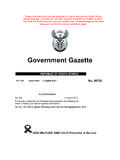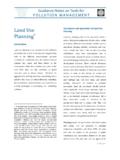Transcription of Land use planning and the siting of nuclear …
1 Health and Safety Executive Health and Safety Executive nuclear Directorate land USE planning AND THE siting OF nuclear INSTALLATIONS IN THE united kingdom A note by the Health & Safety Executive s (HSE) nuclear Installations Inspectorate (NII) , describing the basis for its advice on demographics in relation to developments around existing nuclear licensed sites, and on the siting of proposed nuclear installations Summary Since the start of the civil nuclear power programme in the 1960s, the government has applied a policy of siting new nuclear power plants in areas where the population density does not exceed certain thresholds, and where the growth of that population can be monitored and controlled.
2 This is done by means of land use planning policies which require local planning authorities to carefully consider the impact of new developments within consultation zones around each nuclear site. The aim was to avoid the population around the station steadily rising to an undesirable level. The policy and its application is now extended to all nuclear installations. The UK Government s policy on the siting of nuclear power stations was, in the 1960 s, based on the advice and recommendations of its nuclear Safety Advisory Committee. Responsibility for the implementation of this policy was vested in the nuclear Installations Inspectorate (NII), who developed methods and criteria on which advice could be provided in relation to the siting of new nuclear plants, and subsequently on the control of population around such site after they had begun operation.
3 This note describes HSE s current approach to providing advice in relation to the population distribution (or demographics ) near to proposed or existing nuclear sites. This is particularly pertinent at the moment with the growth of interest in the siting of new nuclear power stations and the note explains how HSE s advice has informed the Government s Strategic siting Assessment process. The main part of this note is descriptive and is intended to be of interest to non-technical readers. Two annexes provide more technical detail and a worked example which will be of interest to those with a more technical background.
4 A Note on land Use planning and the siting of nuclear Installations in the united kingdom Background HSE s regulation of UK health and safety laws require that the nuclear Site Licensees operate their nuclear installations in such a way that risks to employees and to the general public are as low as reasonably practicable (ALARP). HSE applies a range of regulatory procedures, including inspection and assessment to make judgements about the licensee s compliance with the law, through their safety cases and licensing conditions which are benchmarked against international requirements and standards. Although Licensees put in place arrangements to demonstrate compliance with legal controls to ensure that the chances of an accident leading to the release of radioactivity into the environment are very low, the risk of such an accident cannot be eliminated.
5 Measures, to reduce the chance of a release, and control any that occur are based on the reliability and control systems for complex plant and equipment, which is supported by operator procedures. Additionally, emergency preparedness and response arrangements are put in place to minimise and mitigate the health consequences of any significant radiological release that might occur. Emergency arrangements cover the actions to be taken by the local emergency authorities and services, to assist and protect people living in the vicinity of the nuclear installation . The key objective is to ensure that all these planned actions would operate effectively during the course of a potential accident and the subsequent recovery phase.
6 Emergency planning arrangements are regularly practised and tested, with the efficiency and effectiveness of response being related to the assumptions made about population density and controls. For that reason, since the start of the civil nuclear power programme in the 1960s, the government has applied a policy of siting new nuclear power plants in areas where the population density does not exceed certain thresholds, and where the growth of that population can be monitored and controlled. This is done by means of land use planning policies which require local councils to carefully consider the impact of new developments within consultation zones around each nuclear site.
7 The aim was to avoid the population around the station steadily rising to an undesirable level. This policy has been reinforced at public inquires in the 1980s for the development of the Sizewell B and proposed Hinkley Point C power stations. Consultation criteria are in place around all licensed nuclear sites with arrangements for planning authorities to consult NII about planning applications (details can be found at: ) NII s Approach to Demographic Assessment In 2008, the nuclear Installations Inspectorate (NII) produced a paper to the then Health & Safety Commission s nuclear Safety Advisory Committee (NuSAC) (9&10) . The aim was to refresh and update the published demographic criteria for the siting of nuclear installations in the UK, not least to inform UK Government policy on the suitability of sites for proposed new power stations, in terms of their compatibility with surrounding distribution of populations (known as demographics).
8 NII s suggested method for assessing demographics in relation to siting new installations is based on international best practice and guidelines, including those produced by the International Atomic Energy Agency (IAEA) and the NII s Safety Assessment Principles (SAPs)8 for nuclear Facilities. These approaches seek to limit the scale of harmful effects of radiation in the remote chance of an accident at a nuclear facility by limiting the number of people living and working in the vicinity. The approach also acknowledges that new nuclear power stations will be designed and constructed to engineering standards that have been developed from international operating experience over the last 50 years and are therefore expected to be safer than those existing power stations which are nearing the end of operation.
9 Demographics and Advice to Local planning Authorities about new development in the vicinity of nuclear installations The NuSAC paper also reinforced the basis of the method for assessing the significance of population growth arising from new developments in the vicinity of existing nuclear installations. As stated above controls over development have been in place for many years and seek to preserve the desirable population characteristics from the time a nuclear installation is first licensed, and throughout its operating life. NII is consulted by Local planning Authorities (LPAs) and provides advice about certain types of development before the LPA decides on planning permission.
10 NII s advice takes into account the significance of any increase in population and impact on the capability of local emergency arrangements. Strategic siting Assessment (SSA) for new nuclear Power Stations The Government s proposed approach to the assessment and decision making process on the potential suitability of sites for new nuclear power stations will take into account a number of social, environmental and operational factors. Further details about the Government s SSA process can be found at the web site of the Department of Energy and Climate Change (DECC) SSA Criteria & those for Demographic Assessment One of the SSA criteria places a restriction on the local population density and distribution which if exceeded will categorically exclude a site from further consideration.















